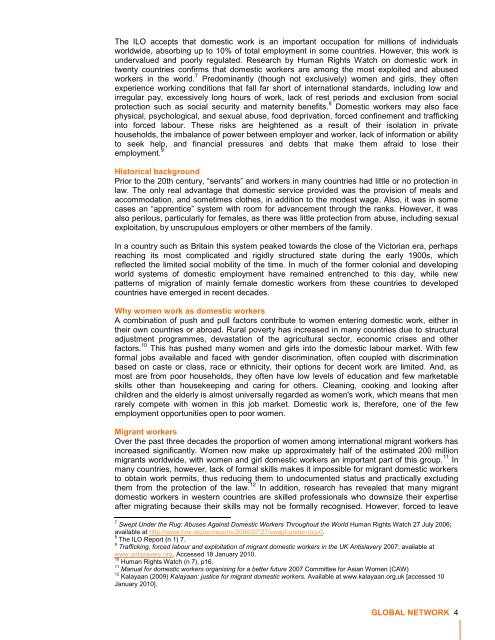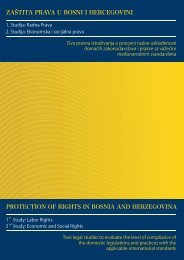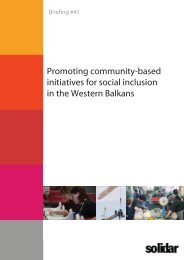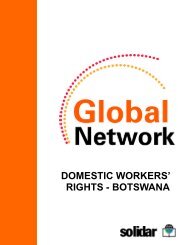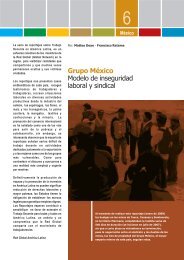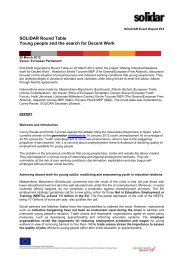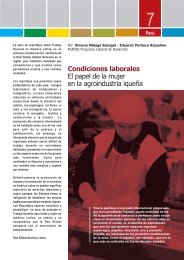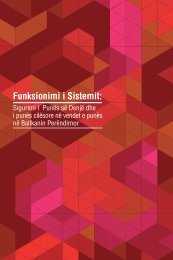domestic workers: decent work for all â south africa - Solidar
domestic workers: decent work for all â south africa - Solidar
domestic workers: decent work for all â south africa - Solidar
Create successful ePaper yourself
Turn your PDF publications into a flip-book with our unique Google optimized e-Paper software.
The ILO accepts that <strong>domestic</strong> <strong>work</strong> is an important occupation <strong>for</strong> millions of individuals<br />
worldwide, absorbing up to 10% of total employment in some countries. However, this <strong>work</strong> is<br />
undervalued and poorly regulated. Research by Human Rights Watch on <strong>domestic</strong> <strong>work</strong> in<br />
twenty countries confirms that <strong>domestic</strong> <strong><strong>work</strong>ers</strong> are among the most exploited and abused<br />
<strong><strong>work</strong>ers</strong> in the world. 7 Predominantly (though not exclusively) women and girls, they often<br />
experience <strong>work</strong>ing conditions that f<strong>all</strong> far short of international standards, including low and<br />
irregular pay, excessively long hours of <strong>work</strong>, lack of rest periods and exclusion from social<br />
protection such as social security and maternity benefits. 8 Domestic <strong><strong>work</strong>ers</strong> may also face<br />
physical, psychological, and sexual abuse, food deprivation, <strong>for</strong>ced confinement and trafficking<br />
into <strong>for</strong>ced labour. These risks are heightened as a result of their isolation in private<br />
households, the imbalance of power between employer and <strong>work</strong>er, lack of in<strong>for</strong>mation or ability<br />
to seek help, and financial pressures and debts that make them afraid to lose their<br />
employment. 9<br />
Historical background<br />
Prior to the 20th century, ―servants‖ and <strong><strong>work</strong>ers</strong> in many countries had little or no protection in<br />
law. The only real advantage that <strong>domestic</strong> service provided was the provision of meals and<br />
accommodation, and sometimes clothes, in addition to the modest wage. Also, it was in some<br />
cases an ―apprentice‖ system with room <strong>for</strong> advancement through the ranks. However, it was<br />
also perilous, particularly <strong>for</strong> females, as there was little protection from abuse, including sexual<br />
exploitation, by unscrupulous employers or other members of the family.<br />
In a country such as Britain this system peaked towards the close of the Victorian era, perhaps<br />
reaching its most complicated and rigidly structured state during the early 1900s, which<br />
reflected the limited social mobility of the time. In much of the <strong>for</strong>mer colonial and developing<br />
world systems of <strong>domestic</strong> employment have remained entrenched to this day, while new<br />
patterns of migration of mainly female <strong>domestic</strong> <strong><strong>work</strong>ers</strong> from these countries to developed<br />
countries have emerged in recent decades.<br />
Why women <strong>work</strong> as <strong>domestic</strong> <strong><strong>work</strong>ers</strong><br />
A combination of push and pull factors contribute to women entering <strong>domestic</strong> <strong>work</strong>, either in<br />
their own countries or abroad. Rural poverty has increased in many countries due to structural<br />
adjustment programmes, devastation of the agricultural sector, economic crises and other<br />
factors. 10 This has pushed many women and girls into the <strong>domestic</strong> labour market. With few<br />
<strong>for</strong>mal jobs available and faced with gender discrimination, often coupled with discrimination<br />
based on caste or class, race or ethnicity, their options <strong>for</strong> <strong>decent</strong> <strong>work</strong> are limited. And, as<br />
most are from poor households, they often have low levels of education and few marketable<br />
skills other than housekeeping and caring <strong>for</strong> others. Cleaning, cooking and looking after<br />
children and the elderly is almost univers<strong>all</strong>y regarded as women's <strong>work</strong>, which means that men<br />
rarely compete with women in this job market. Domestic <strong>work</strong> is, there<strong>for</strong>e, one of the few<br />
employment opportunities open to poor women.<br />
Migrant <strong><strong>work</strong>ers</strong><br />
Over the past three decades the proportion of women among international migrant <strong><strong>work</strong>ers</strong> has<br />
increased significantly. Women now make up approximately half of the estimated 200 million<br />
migrants worldwide, with women and girl <strong>domestic</strong> <strong><strong>work</strong>ers</strong> an important part of this group. 11 In<br />
many countries, however, lack of <strong>for</strong>mal skills makes it impossible <strong>for</strong> migrant <strong>domestic</strong> <strong><strong>work</strong>ers</strong><br />
to obtain <strong>work</strong> permits, thus reducing them to undocumented status and practic<strong>all</strong>y excluding<br />
them from the protection of the law. 12 In addition, research has revealed that many migrant<br />
<strong>domestic</strong> <strong><strong>work</strong>ers</strong> in western countries are skilled professionals who downsize their expertise<br />
after migrating because their skills may not be <strong>for</strong>m<strong>all</strong>y recognised. However, <strong>for</strong>ced to leave<br />
7 Swept Under the Rug: Abuses Against Domestic Workers Throughout the World Human Rights Watch 27 July 2006;<br />
available at http://www.hrw.org/en/reports/2006/07/27/swept-under-rug-0.<br />
8 The ILO Report (n 1) 7.<br />
9 Trafficking, <strong>for</strong>ced labour and exploitation of migrant <strong>domestic</strong> <strong><strong>work</strong>ers</strong> in the UK Antislavery 2007; available at<br />
www.antislavery.org. Accessed 18 January 2010.<br />
10 Human Rights Watch (n 7), p16.<br />
11 Manual <strong>for</strong> <strong>domestic</strong> <strong><strong>work</strong>ers</strong> organising <strong>for</strong> a better future 2007 Committee <strong>for</strong> Asian Women (CAW)<br />
12 Kalayaan (2009) Kalayaan: justice <strong>for</strong> migrant <strong>domestic</strong> <strong><strong>work</strong>ers</strong>. Available at www.kalayaan.org.uk [accessed 10<br />
January 2010].<br />
GLOBAL NETWORK 4


